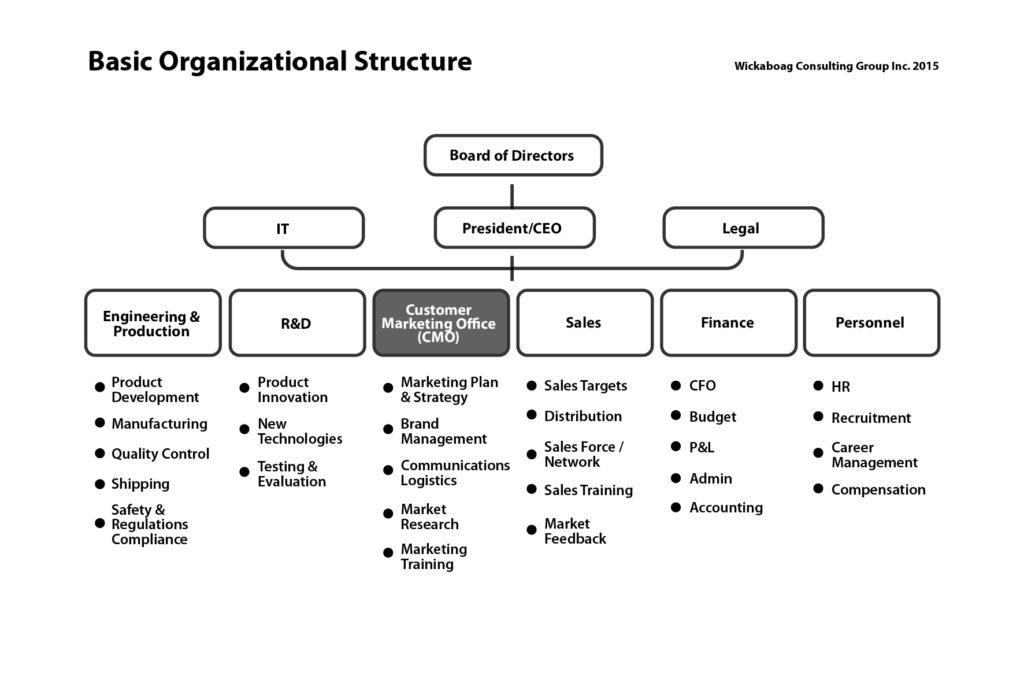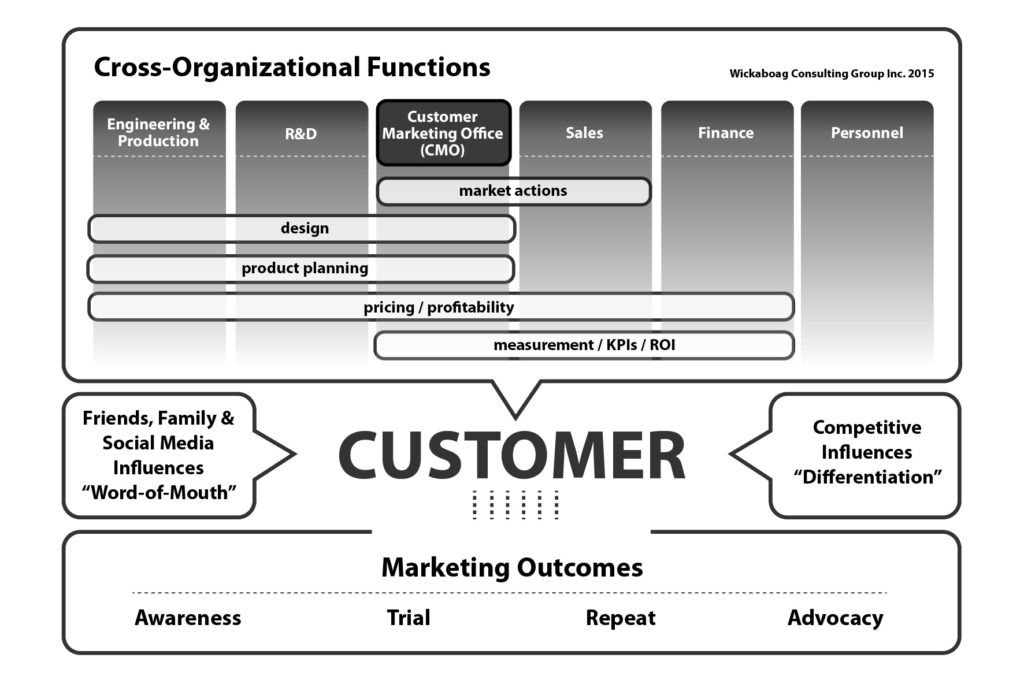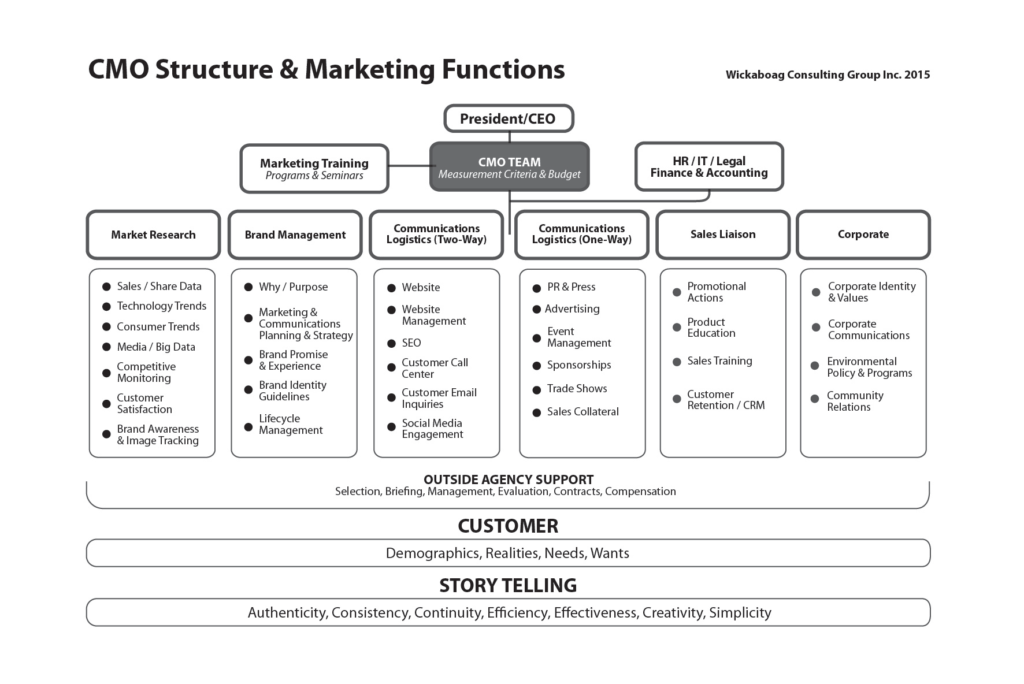This is the third in a series of columns about Japan Inc.’s ultimate global challenge: marketing (if you came here from somewhere else, read this and this first).
Marketing is the process involved to sell a product and brand. It addresses how a product or brand should be perceived by the customer to be more desirable (positioning); where and how it should be sold (selling & distribution); how to motivate purchases (value proposition & promotion); and how to serve and maintain the customer relationship (service).
Marketing’s goal is to bridge the gap between a product/brand and the customer by raising awareness, developing and managing relationships, and owning vehicles to reach them, for example communications and distribution channels.
Marketing plays a key role in the success, sustainability or failure of every business.
Marketing is not an operations or business management activity. It does not involve product innovation, product planning, business strategy, new market identification, business analysis or sales forecasting; though it does play an important support role.
Marketing produces a wealth of knowledge about the customer, products and market, and is important to consult while making better business and product decisions, and supporting related activities.
Marketers are the customer specialists, excitement generators, influencers, deliverymen and concierge that inform, attract, sell and ultimately take care of the customer.
Effectively managing marketing requires a strong understanding of the product/brand and the customer. All marketers must be able to answer five fundamental questions:
- What is the product/brand and what is its purpose?
- Who is it for and why is it relevant to them?
- How should the product/brand make the customer feel? What is the desired experience?
- How, and through what vehicles, can that experience be realized, and what will motivate the customer to engage in a conversation and purchase?
- Why should the customer believe you?
While these questions are essential for all people within an organization to know, questions 4 and 5 particularly rely on marketers.
The problem is that most organizations do not look at marketing this way. Marketing activities typically fall into two categories: Operational and Strategic.
The operational side focuses on the rational aspects of product management. Here is a list of tasks:
- Defining the competitive set
- Category attractiveness analysis
- Competitor analysis
- Market potential and sales forecasting
- Developing a product strategy
- New product decisions or modifications to existing product lines
- Pricing decisions
- Advertising and promotional decisions
- Channel management (where to sell)
- Customer relationship management
- Financial analysis and budgeting
- Marketing return on investment (ROI) measurement metrics
This operational list is how many people inside companies define what marketing does and what they do as marketers.
Operational work needs to be done to produce a product and determine how much of it can potentially be sold, where and at what price. When these tasks are completed, a marketing operations plan is produced. Then what?
Reach out to the intended customer (the prospect) and persuade them to buy. This requires a marketing communications strategy. This is the strategic or emotional side of marketing that manages brands.
Based on my experience, Japanese companies lack internal knowledge and experience to effectively manage brands. Under the marketing umbrella, the same effort that goes into operational planning needs to go into developing and implementing the strategic communications plan.
 Marketing is one of the two basic functions of the business. Therefore, a company’s overall strategy needs to be reflected in its marketing.
Marketing is one of the two basic functions of the business. Therefore, a company’s overall strategy needs to be reflected in its marketing.
Michael Porter’s landmark book Competitive Strategy, first published in 1980, provides a framework for predicting competitor behavior that has transformed the way in which companies look at their rivals, and has given rise to the discipline of competitor assessment.
The following is a summary of his five competitive forces that directly impact a company’s business strategy and thus, its marketing.
- Current competitors
- Threat of new competitors
- Threat of substitutes for its products or services
- Bargaining power of suppliers
- Bargaining power of customers
Within the above environment, a competitive strategy must be chosen, and there are only three possibilities:
- Achieving the lowest costs
- Differentiating products and services
- Dominating a niche
Trying to do some of each results in getting caught in the middle preventing the company from realizing the benefit of any of these strategies, and losing to competitors that chose just one.
Marketing produces four outcomes:
- Awareness: If your target customer does not know your product exists or where to buy it, you are out of business. The very first thing you need to do is create awareness and maintain it over time.
- Trial: Once the target customer has found your product and has decided to buy it for the first time, it is the ultimate moment of truth. Did it meet expectations? If the answer is no, your business is in trouble. If the answer is yes, move to the next point.
- Repeat: You have a satisfied customer who likes your product and appreciates its perceived value. You now have a chance to build an ongoing relationship so they continue to purchase.
- Advocacy: Not only does this customer like your product, but also they are probably interacting with your customer service people, engaged with your marketing messages, activities and offers, and they have joined your Facebook page or other social sites and enthusiast groups. They are telling their friends and family via word-of-mouth, which can be further amplified by social media, blogs, etc.
Every business was once a small business. Some grew to be become massive global corporations, and some went bankrupt or broke up and faded away with changing times. Every business, large or small, public or private, Business-to-Consumer (B2C) or Business-to-Business (B2B) is a mini-nation, city, village or family. They go through various stages. Each has its own history, culture, management style and reason it exists. Marketing plays a key role in the success, sustainability or failure of every business.
The CEO or owner of the business should be directly involved in the marketing. Why? Because as Peter Drucker stated, “Marketing is the distinguishing unique function of the business.”
Depending on the size of the business, the CEO should appoint a Chief Marketing Officer (CMO) or assign one of the senior officers to be responsible for marketing (e.g., Director of Marketing reporting directly to the CEO). This person should have a seat on the board or management committee. Finally, marketing should be recognized as a core function of the company and work cross-functionally in equal partnership with the other parts of the company.
In Japanese companies the CMO position does not exist and marketing is not considered a core function of the business. In the U.S., where the position is common in most companies, CMOs have a high rate of turnover or burn out.
The ideal CMO should have two key talents: 1) to think creativity, 2) to be able analyze data.
A unique opportunity: The Customer Marketing Office
I believe the CMO position in the U.S. has grown too complicated for one person to manage. Japanese companies have a unique opportunity to re-engineer the position by expanding it into a broader group of people to function as a CMO team.
Since CMO is an abbreviation that universally signals the marketing function in a company, my suggestion is for Japanese companies to redefine and rename it the Customer Marketing Office.
A team of executives working collaboratively; each responsible for different marketing functions with a rotating team captain (who speaks directly to the CEO and other board members). This allows for a variety of talents to balance the need for creativity while analyzing massive amounts of complex data.
This spreads out responsibility and pressure so it is NOT all dependent on one superman.
Together, the members of the CMO act as the voice of the customer and represent them inside the company.
A team approach is more flexible to permit response to rapidly changing competitive challenges, shifting consumer trends and the impact of Big Data. Planned rotations allow for a constant inflow of new thinking while retaining wisdom and experience; thus, marketing is integrated into all company functions as an equal team player.
The Customer Marketing Office will lead and mentor the internal marketing organization and be supported by specialist outside agency partners. They establish key performance indicators (KPIs) to measure return on investment (ROI) for marketing expenditures and define what success should look like to justify marketing expenditures to the Chief Financial Officer (CFO). They also report directly to the business owner or CEO, who has to take ultimate responsibility for managing the company brand.
Marketing needs to work cross-functionally and in partnership with the other key functions of the business leading to the customer. This means the mindset of everyone in the organization has to be one of sharing and working collaboratively in an open and honest way. The following three charts are my recommendation of how marketing fits into the overall company business organizational structure, breaks down into various functions and works cross-functionally. This can be modified and adapted to fit company size and product range.
 The first chart shows the basic functions of any business; scalable to the size of company operations and number of employees. The Customer Marketing Office is established as its own function separate from sales.
The first chart shows the basic functions of any business; scalable to the size of company operations and number of employees. The Customer Marketing Office is established as its own function separate from sales.
 The second chart shows how the Customer Marketing Office interacts with the other key functions of the business, and where they have to overlap and work cross-functionally. The combined actions are aimed at the customer. The customer is most influenced by two key factors: on the right, the need to differentiate from the competitors; and on the left, family, friends and social media that have a powerful word-of-mouth influence on how the customer thinks and acts with their wallets. This flows into the four marketing outcomes.
The second chart shows how the Customer Marketing Office interacts with the other key functions of the business, and where they have to overlap and work cross-functionally. The combined actions are aimed at the customer. The customer is most influenced by two key factors: on the right, the need to differentiate from the competitors; and on the left, family, friends and social media that have a powerful word-of-mouth influence on how the customer thinks and acts with their wallets. This flows into the four marketing outcomes.
 The third chart breaks down the Customer Marketing Office responsibilities. At the outset, the CMO Team needs to set the criteria by which all marketing actions and investment will be measured. It also has the ultimate responsibility to convince the CEO and CFO to approve the marketing budget.
The third chart breaks down the Customer Marketing Office responsibilities. At the outset, the CMO Team needs to set the criteria by which all marketing actions and investment will be measured. It also has the ultimate responsibility to convince the CEO and CFO to approve the marketing budget.
The next layer down breaks marketing into six functional areas; the boxes are self-explanatory. These functions are supported by a variety of outside agency partners. The collective output is the story you want to tell the customer.
Someone needs the guts to be first!
These are my recommendations to Japanese business owners and CEOs who desire to implement marketing as a core function of the company’s business:
Separate sales and marketing into two distinct functions and clarify the role or mission of each.
- Create a Customer Marketing Office/CMO function reporting directly to the CEO, elevated to board-level function. The CEO must be directly involved!
- Rearrange the company’s organization and working processes to build in the CMO function.
- Elevate the status of marketing in the company; allow employees to specialize or develop a career in marketing as a skilled profession.
- Introduce an ongoing marketing recruitment and training program with outside help.
- Treat your outside agencies as partners, not suppliers; they advise, you decide!
- Implement a process to measure the ROI, effectiveness, efficiency, consistency and continuity of marketing investments, and kaizen everything through defining your KPIs.
- Build in incentives and rewards for the CMO team and outside partners.
If Japanese CEOs can convince their management team and board of directors to embrace the Customer Marketing Office/CMO function, the result of fully embracing marketing as a core function can help companies to:
- Maintain or regain innovation leadership.
- Hit sales goals and build market share with better margins.
- Increase brand value in the mind of the customer (and within the financial community).
- Have a motivated and focused company organization aligned behind a clear marketing and communications plan and strategy.
Japan needs more progressive CEOs to be marketing champions. The future success of Japanese businesses and all the people they employ around the world are dependent on this vital change from business-as-usual practices. Someone needs the guts to be first!
My next column will cover the marketing basics Japanese companies need to master.



No comments yet.